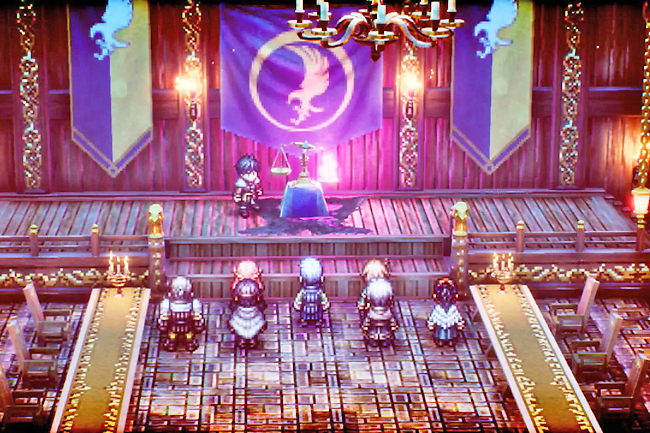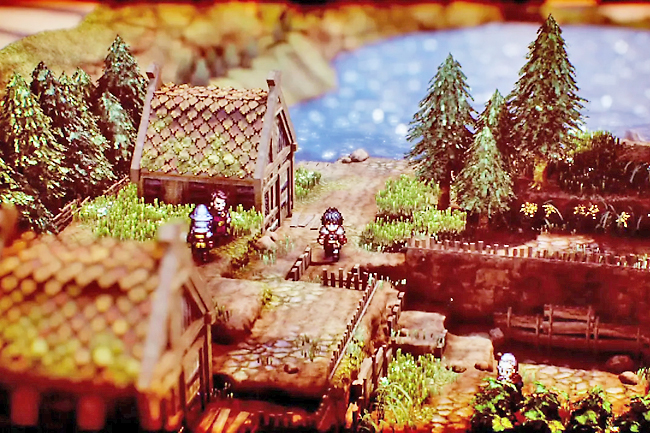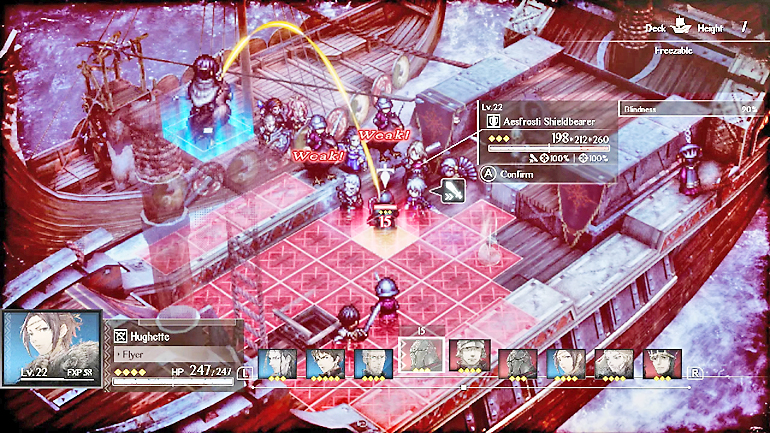George Yang
THE WASHINGTON POST – When Triangle Strategy was first announced, the hype for Square Enix’s newest role-playing game mostly focussed on its tactical gameplay elements similar to fan-favourite Final Fantasy Tactics or its gorgeous HD-2D art style, a blend of 2D character sprites with HD polygonal graphics popularised by another Square Enix game, 2019’s Octopath Traveler. However, after spending almost 30 hours on my first playthrough, I can confidently say that where Triangle Strategy truly shines is in its worldbuilding.
When faced with tough decisions, I felt that I had agency; my choices impacted the events that unfolded throughout the game. By the time I reached the end, I knew that the last few decisions I made would have irreversible consequences on the story as well as the comrades I’d grown close to along the way.
The story unfolds on the continent of Norzelia, which is divided into three countries: Glenbrook, Aesfrost and Hyzante. Thirty years ago, the three nations warred over the land’s precious iron and salt resources. Their rocky truce is jeopardised when one nation, seemingly out of nowhere, decides to invade another. Protagonist Serenoa Wolffort and his companions must navigate the delicate power structures and political influences of each nation to restore peace; acting on behalf of House Wolffort, the most powerful military force in Glenbrook, their actions will permanently shape the future of Norzelia.
In certain pivotal moments, Serenoa will bring out the Scales of Conviction, where each party member votes on which course of action to take to resolve a specific conflict. In the beginning, these decisions are relatively benign, simple questions like where the party should head to first. As the plot gets rolling, though, the stakes ramp up significantly, making it difficult to gauge which decision could be the morally “right” one.
Should Wolffort blast the side of a building to ensure a victory against an opponent, but risk hurting innocent bystanders? Or should the party sneak their way in and try to negotiate peacefully, knowing that the talks could fall apart? The game begins by giving players two choices in these instances; as the plot progresses the number of options increases in certain scenarios. It’s up to the player to weigh the positives and negatives of each – and secure the necessary voting bloc.



Your main cast of party members will have their own opinions on which route to take, though you can convince them to change their minds. During certain parts of the story you enter an “exploration area” and can chat with nearby nonplayable characters (NPCs). It’s in your best interest to do so: They’ll offer important context about the current conflict, unlocking certain dialogue choices that you can use to persuade the other party members as to which path to vote for.
For example, were you leaning toward blowing up the side of a building? Well, an NPC could bolster your case for that approach by sharing a rumour that the guards recently found a secret path and have since sealed it off. You can use that piece of information to argue against a party member who’s voting for sneaking into the building. It’s a clever way of getting players to learn about the world, while also having a tangible effect on gameplay and the story. I found myself invested in deciding which path to take, wracking my brain to figure out the potential consequences – a testament to Triangle Strategy’s engaging worldbuilding.
However, as interesting as the world of Triangle Strategy is, it’s let down somewhat by the mediocre English voice acting throughout the game, which is particularly surprisingly given the pedigree of Square Enix and Nintendo. Many of the lines are delivered flatly, and sound stilted.
The characters’ American accents often feel at odds with the game’s script, which leans into Olde English vernacular, using words and phrases like “shant” and “pray tell”.
At first, I assumed Square Enix cast less experienced voice actors, but when I finished the game and credits rolled, I saw many familiar names from other games and anime – and they’ve all given much better performances than they do in Triangle Strategy. That being said, players do have the option of switching to the Japanese voice track with subtitles.
As for combat, Triangle Strategy’s tactics feel simple but intuitive and aren’t bogged down with complexity. Players take turns moving their party members across a grid-based field. To win battles and defeat enemy soldiers, positioning your units properly is key. Units attacking from higher ground will deal increased damage, and attacking units from behind results in a critical hit. Additionally, when an enemy is struck with a physical attack, any allies directly on the opposite side of that enemy will perform follow up attacks.
The environment plays a big part in battle too. For example, lightning elemental attacks travel through puddles and damage all units standing in them. Squares that are on fire will inflict damage to units travelling through them or standing on them at the end of their turn. You can also manipulate the terrain using magic, such as by using an ice spell to create a frozen panel and then melting it with a fire spell to make a puddle. It’s a fun system that encourages experimentation and adds depth to the overall gameplay.
What I also like about Triangle Strategy is the simplicity in character progression. You can collect materials from exploration areas or loot them off enemies, which can then be used to upgrade your team’s gear and enhance their abilities. There aren’t any split paths in terms of promoting units, as is typical in other tactics-based RPG series like Final Fantasy or Fire Emblem. For example, Serenoa’s Swordfighter class doesn’t have the option to branch off into subcategories like Swordmaster or Ninja that favour certain stats or unlock unique abilities; he just has a single progression path.
Some players may find these lack of character customisation options disappointing. However, I appreciated the fact that I didn’t have to worry about whether I had bought the latest weapons and armour after every story mission like in other RPGs.
Additionally, the more you deploy certain characters in battle, the higher chance you have to activate their specific character stories, cutscenes that provide additional context and backstory about your comrades. You start out with fewer than 10 units, but you can recruit more characters throughout the game. A majority of them aren’t significantly connected to the main story and don’t participate during the voting process. But they all come with their own backstories and hang around the main encampment where they offer services like operating storefronts for you to buy items and materials from.
One issue I struggled with throughout the game was keeping my party sufficiently levelled up, which sometimes made battles difficult. As more characters join you, you have to be increasingly selective about who you bring into battle. Benched characters can’t earn experience points from battles they’re not in. As a result, I felt under-levelled throughout the majority of the game, with my highest level unit, Serenoa, often hovering two levels under the recommended threshold shown on the map.
The encampment does have mock battles to help your less powerful units gain experience and catch up. However, the grind can be tedious if you want everybody to stay relatively equal, though the simplicity of the progression system streamlines the experience a bit.
Additionally, the game is approachable with various difficulty modes, including Very Easy, which lets people experience the plot without getting stuck in battles.
Triangle Strategy is clearly designed for multiple playthroughs. There are different story paths depending on where your party’s decisions take you, as well as the New Game+ option after you’ve completed the game. While the central plot of the game remains relatively the same regardless of what you choose, selecting different story paths will allow players to witness a wider variety of perspectives. The differences becomes more pronounced toward the later chapters. For example, choosing one path might reveal a crucial detail about a character’s backstory that you wouldn’t have learned had you chosen another.
Triangle Strategy is a fun title that has an engaging story with fantastic characters and worldbuilding. Better English voice acting would have been icing on the cake, but the half-baked vocal delivery left me feeling a bit deflated. In any case, fans of strategy and tactics-based RPG games should definitely check Triangle Strategy out.







